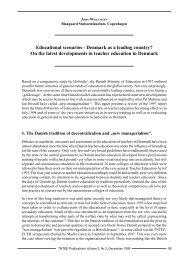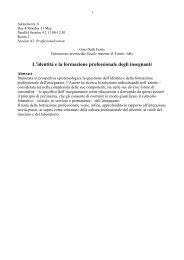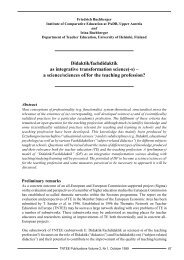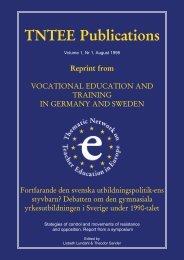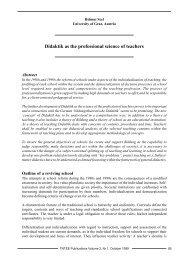- Page 1: TNTEE Publications Volume 2, Nr 1,
- Page 4 and 5: ACKNOWLEDGEMENTS The production of
- Page 6 and 7: Section II: Specific Subject Didact
- Page 8 and 9: 2 broadly conceived as “capabilit
- Page 10 and 11: 4 Friedrich Buchberger and Irina Bu
- Page 12 and 13: 6 phenomenological perspective is n
- Page 14 and 15: 8 Buchberger in this publication. T
- Page 16 and 17: 10 Section 3 Interdisciplinary Issu
- Page 18 and 19: 12 holistic view of the structure o
- Page 20 and 21: 14 “Allgemeine Didaktik” (“Ge
- Page 22 and 23: 16 “Allgemeine Didaktik” (“Ge
- Page 26 and 27: 20 Materials Figure 5 “Allgemeine
- Page 28 and 29: 22 The Deutsche Didaktik and the Am
- Page 30 and 31: 24 The Deutsche Didaktik and the Am
- Page 32 and 33: 26 The Deutsche Didaktik and the Am
- Page 34 and 35: 28 The Deutsche Didaktik and the Am
- Page 36 and 37: 30 The Deutsche Didaktik and the Am
- Page 38 and 39: 32 The Deutsche Didaktik and the Am
- Page 40 and 41: 34 The Deutsche Didaktik and the Am
- Page 42 and 43: 36 TNTEE Publications Volume 2, Nr
- Page 44 and 45: 38 Seeking connections between diff
- Page 46 and 47: 40 Seeking connections between diff
- Page 48 and 49: 42 Seeking connections between diff
- Page 50 and 51: 44 Seeking connections between diff
- Page 52 and 53: 46 Seeking connections between diff
- Page 54 and 55: 48 TNTEE Publications Volume 2, Nr
- Page 56 and 57: 50 Existing models of knowledge in
- Page 58 and 59: 52 Existing models of knowledge in
- Page 60 and 61: 54 Existing models of knowledge in
- Page 62 and 63: 56 Existing models of knowledge in
- Page 64 and 65: 58 Existing models of knowledge in
- Page 66 and 67: 60 Existing models of knowledge in
- Page 68 and 69: 62 Existing models of knowledge in
- Page 70 and 71: 64 Existing models of knowledge in
- Page 72 and 73: 66 Existing models of knowledge in
- Page 74 and 75:
68 Didaktik/fachdidaktik as integra
- Page 76 and 77:
70 Didaktik/fachdidaktik as integra
- Page 78 and 79:
72 Didaktik/fachdidaktik as integra
- Page 80 and 81:
74 Didaktik/fachdidaktik as integra
- Page 82 and 83:
76 Didaktik/fachdidaktik as integra
- Page 84 and 85:
78 Didaktik/fachdidaktik as integra
- Page 86 and 87:
80 Didaktik/fachdidaktik as integra
- Page 88 and 89:
82 Didaktik/fachdidaktik as integra
- Page 90 and 91:
84 TNTEE Publications Volume 2, Nr
- Page 92 and 93:
86 Didaktik as the professional sci
- Page 94 and 95:
88 Didaktik as the professional sci
- Page 96 and 97:
90 Didaktik as the professional sci
- Page 98 and 99:
92 Didaktik as the professional sci
- Page 100 and 101:
94 TNTEE Publications Volume 2, Nr
- Page 102 and 103:
96 Reflection as a bridging concept
- Page 104 and 105:
98 Reflection as a bridging concept
- Page 106 and 107:
100 Reflection as a bridging concep
- Page 108 and 109:
102 Reflection as a bridging concep
- Page 110 and 111:
104 Reflection as a bridging concep
- Page 112 and 113:
106 TNTEE Publications Volume 2, Nr
- Page 114 and 115:
108 The didactic relation in the te
- Page 116 and 117:
110 The didactic relation in the te
- Page 118 and 119:
112 The didactic relation in the te
- Page 120 and 121:
114 The didactic relation in the te
- Page 122 and 123:
116 The didactic relation in the te
- Page 124 and 125:
118 On central dimensions of teache
- Page 126 and 127:
120 On central dimensions of teache
- Page 128 and 129:
122 On central dimensions of teache
- Page 130 and 131:
124 On central dimensions of teache
- Page 132 and 133:
126 TNTEE Publications Volume 2, Nr
- Page 134 and 135:
128 Epistemologies, beliefs and con
- Page 136 and 137:
130 Epistemologies, beliefs and con
- Page 138 and 139:
132 Epistemologies, beliefs and con
- Page 140 and 141:
134 Epistemologies, beliefs and con
- Page 142 and 143:
136 Epistemologies, beliefs and con
- Page 144 and 145:
138 Epistemologies, beliefs and con
- Page 146 and 147:
140 Epistemologies, beliefs and con
- Page 148 and 149:
142 Epistemologies, beliefs and con
- Page 150 and 151:
144 Epistemologies, beliefs and con
- Page 152 and 153:
146 Epistemologies, beliefs and con
- Page 154 and 155:
148 Mathematik Didaktik (Teaching-L
- Page 156 and 157:
150 Mathematik Didaktik (Teaching-L
- Page 158 and 159:
152 Mathematik Didaktik (Teaching-L
- Page 160 and 161:
154 Mathematik Didaktik (Teaching-L
- Page 162 and 163:
156 Mathematik Didaktik (Teaching-L
- Page 164 and 165:
158 Theories and practices of teach
- Page 166 and 167:
160 Mathematik Didaktik (Teaching-L
- Page 168 and 169:
162 Preservice and in-service train
- Page 170 and 171:
164 Preservice and in-service train
- Page 172 and 173:
166 Preservice and in-service train
- Page 174 and 175:
168 Preservice and in-service train
- Page 176 and 177:
170 Preservice and in-service train
- Page 178 and 179:
172 Preservice and in-service train
- Page 180 and 181:
174 Sources of ‘didaktization’
- Page 182 and 183:
176 Sources of ‘didaktization’
- Page 184 and 185:
178 Sources of ‘didaktization’
- Page 186 and 187:
180 Sources of ‘didaktization’
- Page 188 and 189:
182 Sources of ‘didaktization’
- Page 190 and 191:
184 Sources of ‘didaktization’
- Page 192 and 193:
186 TNTEE Publications Volume 2, Nr
- Page 194 and 195:
188 Shifts of paradigm It has been
- Page 196 and 197:
190 Shifts of paradigm Mentalistic
- Page 198 and 199:
192 Shifts of paradigm restructured
- Page 200 and 201:
194 Shifts of paradigm Among other
- Page 202 and 203:
196 Models and structures in social
- Page 204 and 205:
198 Models and structures in social
- Page 206 and 207:
200 Models and structures in social
- Page 208 and 209:
202 Models and structures in social
- Page 210 and 211:
204 Models and structures in social
- Page 212 and 213:
206 Models and structures in social
- Page 214 and 215:
208 Issues of Didactics in Teacher
- Page 216 and 217:
210 Issues of Didactics in Teacher
- Page 218 and 219:
212 Issues of Didactics in Teacher
- Page 220 and 221:
214 Issues of Didactics in Teacher
- Page 222 and 223:
216 Teaching methodologies in initi
- Page 224 and 225:
218 Teaching methodologies in initi
- Page 226 and 227:
220 Teaching methodologies in initi
- Page 228 and 229:
222 Teaching methodologies in initi
- Page 230 and 231:
224 Teaching methodologies in initi
- Page 232 and 233:
226 Teaching methodologies in initi
- Page 234 and 235:
228 The role of subject didactics i
- Page 236 and 237:
230 The role of subject didactics i
- Page 238 and 239:
232 The role of subject didactics i
- Page 240 and 241:
234 The role of subject didactics i
- Page 242 and 243:
236 TNTEE Publications Volume 2, Nr
- Page 244 and 245:
238 Overcoming the gap between theo
- Page 246 and 247:
240 Overcoming the gap between theo
- Page 248 and 249:
242 Overcoming the gap between theo
- Page 250 and 251:
244 Overcoming the gap between theo
- Page 252 and 253:
246 Overcoming the gap between theo
- Page 254 and 255:
248 TNTEE Publications Volume 2, Nr
- Page 256 and 257:
250 Irina Buchberger University of
- Page 260:
TNTEE Publications are presented by



